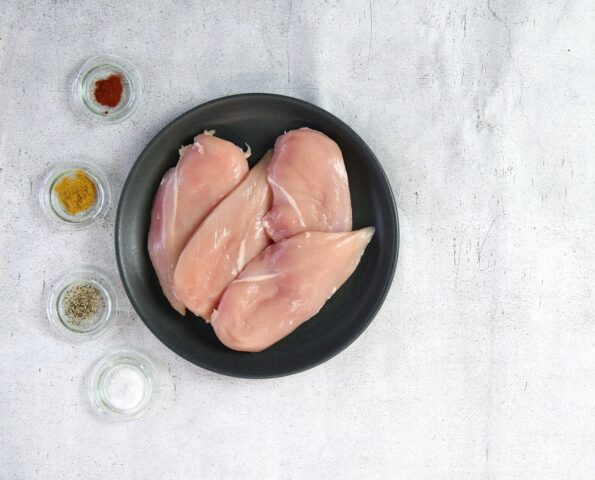An uncooked chicken bosom estimating around 2/3 cup when cut up, weighing 4 ounces crude (boneless and skinless), is identical to 3 ounces of cooked chicken bosom.
Regularly, two parts of an entire chicken are isolated during the butchering system and sold separately as bosoms. A chicken bosom is essential for the pectoral muscle found on the underside of the bird.
174g is the normal load of a chicken bosom; notwithstanding, a few distinct sizes are accessible, from around 4 oz to up to 10 oz. The right size relies upon what you are cooking and the way that enormous it should be.
On the off chance that you’re buying chicken bosoms for your most recent culinary trick, you presumably need to know the number of ounces in a chicken bosom is.
Yet, you probably won’t have any food scales at home to gauge precisely. Furthermore strolling all over the staple walkways, gazing confoundingly at the items on offer that have clacked their last cackle, could leave you feeling pretty befuddled.
You may also like:-
How Much Do Different Types of Chicken Breasts Ounces?
Certainly, you need to know what number of ounces are in a chicken bosom, correct?
All things considered, the inquiry’s not generally so basic as it initially shows up. The heaviness of a chicken bosom relies upon a couple of factors, similar to whether it’s cooked, frozen, or still has the bone left in. Ugh, simply be *easy*, chicken bosom estimations! Goshdarnit!

How many ounces in a chicken breast.
How about we investigate the distinction different arrangements of chicken bosom makes.
-
Bone-in
Bone-in chicken bosoms are otherwise called divided chicken bosoms.
Many individuals lean toward cuts of meat that are as yet on the bone. They assist with keeping the meat super moist during cooking and sneak up suddenly of flavour.
It could sound all fancy-schmancy, however, they’re frequently really less expensive than boneless assortments. Additional flavor for less money? Certainly.
The bones in split chicken bosoms will make up around 20% of their all-out weight, yet you’ll get a comparable measure of meat as boneless chicken bosoms once cooked.
-
Boneless
These are your classic chicken breasts that will be suitable for most food-based fowl forays in the kitchen.
An average chicken breast weighs 174 g, or about 6 ounces (oz). But sizes vary from smaller cuts at around 4 oz, to larger ones at 8 to 10 oz.
There’s no right or wrong choice here. It depends on what you’re cooking and how much chicken you want.
-
Raw vs. Cooked
Chicken breasts will decrease in size when you cook them. That’s because you cook off a lot of the water and fat, which adds extra weight.
A raw chicken breast will lose roughly 25 per cent of its weight and size when it’s cooked. So, it might be worth accounting for that in your cooking calculations.
For example, one 6-oz (174 g) raw chicken breast will weigh around 4.5 oz (130.5 g) once cooked.
Any type of cooking, including oven-roasting and grilling, will cause the chicken to shrink. (“Chicken Little,” anyone?) Boiling or braising will result in less shrinkage though, as those cooking methods rely more on moisture.
-
Thawed vs. Frozen
If you’re buying your chicken breasts fresh and storing them in the freezer, they’ll weigh the same whether they’re fresh, frozen, or thawed.
But it’s a little different if you’re buying chicken breasts pre-frozen. Many of these products contain a special coating that stops them from sticking together. This adds to the weight of the chicken.
You’ll have to thaw the breasts first before you weigh them to get an accurate measurement.
How Much An Average Chicken Breast Ounces?
Counting the heaviness of a chicken bosom. Either for an eating routine or cooking purposes. It’s almost certainly the case there is a normal sum that most gauge. Boneless, skinless chicken bosoms can be determined to weigh between these sums.
Chickens developed today are a lot bigger than they were 40 years prior. This is because of particular rearing and better sustenance.
This implies the chicken bosoms are a lot bigger also and could keep on expanding in size. Chickens don’t have bosoms. What we call the bosom is a pectoral muscle.

How many ounces in a chicken breast.
The muscle shows up on the two sides of the chicken’s chest. Then, at that point, it is cut where this practically normal detachment happens. For that reason, they are now and then called bosom parts.
So assuming you see a formula calling for bosom parts, recollect this is simply one more approach to saying chicken bosom. You don’t need to slice it down the middle to get the right sum.
Thinking for calling them bosoms is a direct result of where they show up in the chicken. A chicken doesn’t have areolas yet it does a muscle joined to its ribs called bosoms.
Sizes in all actuality do change with every chicken bosom, however for the most part they don’t get a lot bigger than 12 oz. The present poultry bosoms are bigger and 8 – 10 oz sizes are exceptionally normal in staple stores. They suggested serving size for chicken bosoms is 3 – 4 ounces.
You can get a decent gauge by knowing how to pass judgment on different loads utilizing a couple of simple techniques. At last, you will want to appraise reasonably effectively each weight without requiring a scale.
-
Average Weight of Chicken Breast
Rarely do I buy a single chicken breast from the meat department did you know how many ounces in a chicken breast? Since the packaged chicken breast is more convenient and cost-effective. They typically come with three or four boneless breasts per pack.
The weight of each package is slightly different and priced per pound. I don’t always do the math to see what each breast might way individually.
Check the package’s total weight and divide that by the number of chicken breasts. This will give you roughly the size of each breast. Chicken breasts can range in size from 2 ounces up to 12. Commonly a serving size of a chicken filet is 4 oz. There is one good way to judge the various sizes without a scale. You can eyeball the weights after some experience.
A good serving of chicken is slightly smaller than a human hand. Anything bigger and that is a very large chicken breast. That would probably weigh in around 10 or more ounces.
This is another way to judge portions of food. The recommended serving for meats is equal to the palm-size of your hand.
-
How Many Boneless Chicken Breasts In A Pound.
Chicken breast sizes vary from different packages. Each pack they come in should give the total weight. Since they are priced per pound and usually overall the pack is more than one pound.
You can estimate if you don’t have the wrapping or labelling for whatever reason. Maybe you threw it away already, but you want to know how much chicken you bought.
Depending on the size of your chicken breast, generally, you could say two chicken breasts are going to be around one pound. Two 8 oz chicken breasts would be equal to one pound in weight. Eight-ounce chicken breast is fairly large.
In comparison, a 4-ounce raw boneless chicken breast is about the size of a deck of cards. An 8 – 10 ounce chicken breast is comparable to the biggest iPhone.16 ounces in a pound so you would need 4 of those to equal one pound.
A lot of times a pack of poultry breasts gives a weight measurement in grams. One pound is equal to 450 grams, so again use the deck of card comparison. One hundred grams is about a serving size equal to the size of a deck of cards. If the package uses kilograms or KG, then you can figure it is more than one pound. Since 1 kilogram is equal to around 2.2 pounds.
The easiest way to get this measurement is to look for a pack weighing close to one pound. Each package varies in weight so pick through a few to find one close. Also using a kitchen scale is the most exact way to weigh each chicken breast.
-
How Much Does An Average Chicken Breast Weigh In Grams?
On average a raw boneless skinless chicken breast will weigh between 85 grams (3 oz) to 225 grams (8 oz). 1 ounce is equal to 28 grams.
-
What Are Chicken Breast Halves?
Chickens grown today are much larger than they were 40 years ago. This is due to selective breeding and better nourishment.
This means the chicken breasts are much larger as well and could continue to increase in size. Chickens don’t even have breasts. What we call the breast is a pectoral potency.
The muscle occurs on both sides of the chicken’s chest. Then it is cut where this almost natural detachment occurs. That is why they are sometimes called breast halves.
So if you see a recipe calling for breast halves, remember this is just another way of saying chicken breast. You don’t have to cut it in half to get the correct amount.
The reasoning for calling them breasts is because of where they appear in the chicken. A chicken doesn’t have nipples but it does a muscle attached to its ribs called breasts.
-
Does Frozen Chicken Weigh More?
Frozen meats or chicken does not weigh more than thawed. Frozen water collecting on the meat might add a very small amount of weight.
Overall the weight is not going to be any different between frozen and thawed. So you can go ahead and weigh them frozen if you are using a scale. The weight will not change when you thaw it out.
-
Raw Weight vs Cooked.
Cooking meat is going to decrease a lot of the raw weight. Notice a lot of meats shrink when they are cooked. Because a lot of the water and fat is cooked away, taking away some of the original weight.
Chicken is no different and shrinks quite a lot during the cooking process. The consensus is that chicken, beef, and even fish shrink by about 25 per cent.
The size of the chicken breast does affect how much it shrinks. Since the 25% of a larger number is more. A larger chicken breast is going to shrink more than a smaller one.
The difference is not very noticeable, but for comparison, a 4 oz breast will shrink to a 3 oz. An 8 oz will shrink down to around 6 oz of meat left.
Any type of cooking method that drys the meat will cause it to shrink. Boiling or braising does not cause the meat to shrink as much.
Here is a basic table giving the different weights for chicken after being cooked.
How To Portion Chicken Breast?
You can cut down chicken breasts that are too large for cooking. It is hard to find decent size portions of poultry sometimes.
As mentioned chickens are getting bigger and the cuts are large. Sometimes more than one person can eat. So here is an easy way to cut down a chicken breast before cooking.
This can be useful as well to get the sizes equal for even cooking. Also doing this reduces cooking time.
You are going to want to cut the chicken breast in half. The mistake people make when doing this is they slice downward and vertical. Leaving two thick slices of chicken.
You want to end up with two chicken halves that are both flat on one end. The flat sides should be the larger of the surfaces.
Butterflying or butterfly slicing is the term used for this type of cutting. I added an extra step to get two separate pieces of chicken.
- Place left hand on top of chicken breast
- Place knife sideways halfway down on chicken breast
- Let the knife do the work and slice across from right to left. (opposite if you’re left-handed)
- Then slice down the middle of the heart-shaped chicken breast.
FAQs Related to How Many Ounces in a Chicken Breast?
1: How much is an average chicken breast?
Three ounces.
- Measure & Unit name = g = oz
- kg, kilogram (1,000g) 1,000.00 g 35.27 oz
- oz, ounce (28.35g) 28.35 g 1.00 oz
- lb, pound (16oz) 453.59 g 16.00 oz
- serving 2 slices 42.00 g 1.48 oz
Subsequently, one may also ask, how many ounces are in a chicken breast?
Adults in the United States are dealing with weight issues in large numbers. Fortunately, we are not. The serving size for chicken, however, is 4 oz. Boneless chicken breasts used to weigh about 4-5 oz., but lately, leaner breasts weigh longer. I’ve noticed that they’re getting bigger and bigger.
2: What is the gram weight of 4 ounces of chicken?
A 4-ounce roasted chicken breast contains slightly more than 25 grams of protein. If you prefer thigh meat, 4 ounces boneless, skinless thigh includes 28 grams of protein. The drumsticks, too, add a lot of protein to your dish.
3: What is the weight of a 4 oz chicken breast?
A single serving of chicken should be 3-4 ounces, roughly the size of a deck of playing cards. Some people use their hand’s palm as a guide. According to the vendors, some chicken breasts look and feel twice or even three times larger than the recommended serving size. 4 oz of chicken breast equals how many cups?
An uncooked chicken breast measuring about 2/3 cup when cut up, weighing 4 ounces raw (boneless and skinless), is equivalent to 3 ounces of cooked chicken breast.
4: What are 8 ounces of chicken in cups?
equivalent values amount, in grams (g) amount, in ounces (oz)
- 7/8 cup 110 g 3.9 oz
- 1 cup 125 g 4.4 oz
- 2 cups 250 g 8.8 oz
- 4 cups 500 g 17.6 oz
5: How much are 6 ounces of meat?
Because hand sizes differ, compare your fist size to the size of a measuring cup. A daily diet should include two servings, or 6 oz., of lean meat (poultry, fish, shellfish, or beef). With your palm, determine the appropriate amount. One palm-sized portion equals three ounces or one serving.
6: How many calories are in 4 ounces of chicken breast?
- Values for cooked (roasted) product
- Nutrient Skinless, boneless breast Whole Chicken, meat and skin
- Calories 165 239
- Protein (grams) 31 24
- Total fat (grams) 3.6 13.4
7: What is the calorie count of a 6oz chicken breast?
The calorie count for chicken breasts is 276.
8: What’s the deal with the enormous size of chicken legs?
Today’s chickens are bigger and grow faster! Farmers have worked to create larger and healthier chickens to meet the increased demand for chicken as a protein, particularly chicken parts like breasts or thighs rather than whole birds.
9: A cup contains how many grams?
- Dry Goods
- Cups Grams Ounces
- 1/2 cup 100 g 3.55 oz
- 2/3 cup 134 g 4.73 oz
- 3/4 cup 150 g 5.3 oz
- 1 cup 201 g 7.1 oz
10: Can you tell me the average chicken breast weight?
The raw weight of the breast and skin from a 1 pound chicken is approximately 6 oz (170 grams). They can, however, be much larger. If you’re counting carefully, you can’t rely on an average. I usually get boneless skinless chicken breasts that weigh around 18 ounces.
11: What’s the deal with the huge chicken breasts?
Excessive poultry yoga. The birds are confined in cages. The hormones specifically target the breast muscle because it will grow the largest and fastest, and it is generally the most preferred part of the chicken. A leg can only hold so much meat, whereas the breast can grow significantly larger.
12: 1kg equals how many chicken breasts?
Each bag contains up to four to six chicken breasts, depending on their weight.
13: How do I weigh 4 ounces of chicken?
You may also use your hand to measure meat and produce portions. A single 3-ounce serving of chicken, beef, or fish, for example, is roughly the size of your palm. A cup of fruit or vegetables is about the size of your closed fist. One serving of cheese is approximately the size of your thumb.
14: What is the gram weight of 5 oz of chicken?
Chicken is high in protein.
The protein content of five ounces of roasted chicken breast is 44 grams. If you prefer dark meat, 5 ounces of cooked thigh meat contains 36.5 grams of protein.
15: 6 ounces of chicken equals how many grams?
6 ounces chicken breast is equal to around 54 g.
16: 20 grams of protein equals how many ounces?
1 ounce of cooked meat contains approximately 7 g of protein. The amount of protein in 4 ounces of raw boneless skinless chicken breast is about 3 ounces after cooking or 21 grams. To get started, try these simple chicken breast recipes. The average healthy adult requires about 0.8 g of protein per kilogram of body weight.
17: What is the calorie count of 2 ounces of cooked chicken?
2 ounces of cooked chicken = 85 calories
18: What is the calorie count of 2 ounces of chicken breast?
2 ounces of chicken breasts can have 92 caloric units.
19: Why are the chicken breasts so big?
20: How do I measure 4 oz of chicken?
You can also use your hand to measure food portions of meat and produce. For example, a single 3-ounce serving of chicken, beef, or fish is roughly the size of your palm. A one-cup serving of fruit or vegetables is roughly the size of your closed fist. A single serving of cheese is about the size of your thumb.
Conclusion
If you use chicken breast often, you have certainly needed to know at least once how much a chicken breast weighs.
On average, a boneless and skinless chicken breast weighs between 6-10 ounces. A bone-in chicken breast that still has the skin on weighs a few ounces more – from 11 to 16 ounces. Chicken breast shrinks and gets lighter when cooked.
Chicken breast is one of the most popular proteins. It is easy to find and cook with. Plus, the neutral flavour profile makes it many people’s favourite chicken cut.
This article is a complete guide to chicken breast sizes.

